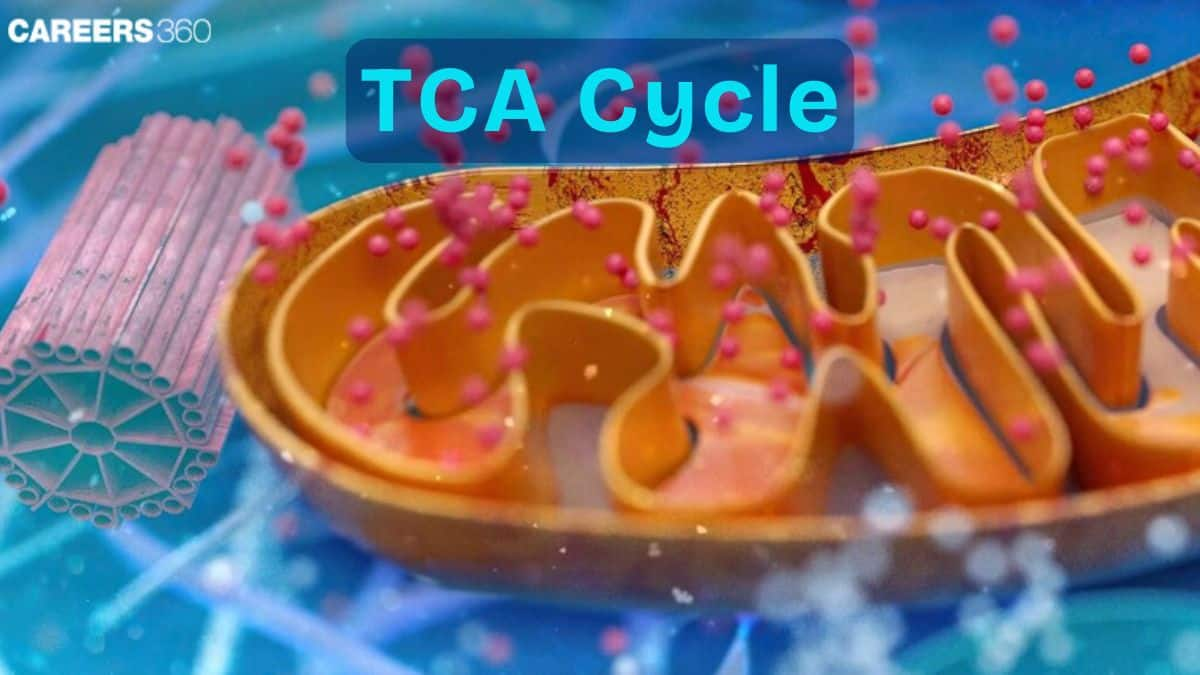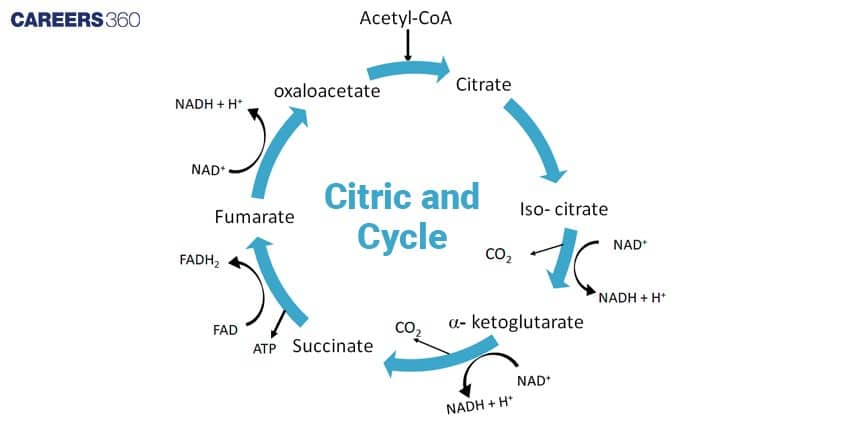TCA Cycle (Tricarboxylic Acid Cycle): Biochemistry, Metabolism, Enzymes
The TCA cycle, also called the citric acid cycle or Krebs cycle, is the aerobic metabolic pathway that oxidizes Acetyl-CoA into CO₂, generating NADH, FADH₂, and ATP/GTP. It occurs in the mitochondrial matrix and forms the central hub of energy metabolism in all aerobic organisms. Understanding its steps, enzymes, and regulation is essential for NEET and Class 11 respiration chapters.
This Story also Contains
- What Is The TCA Cycle?
- Overview Of The TCA Cycle
- Steps of the TCA Cycle (8 Steps, Enzyme-Based)
- End Products Of The TCA Cycle
- Importance Of The TCA Cycle
- TCA Cycle Regulation
- Link Between Glycolysis & TCA Cycle
- TCA Cycle NEET MCQs (With Answers & Explanations)
- Recommended video on TCA Cycle

What Is The TCA Cycle?
The TCA cycle is also called the Krebs or citric acid cycle. It is one of the most basic metabolic pathways of cellular respiration. The process is the second step in aerobic respiration in the mitochondrial matrix of eukaryotic cells. The TCA cycle is the pathway through which the complete oxidation of acetyl-CoA, originating from carbohydrates, fats, and proteins, takes place into carbon dioxide and energy.
Overview Of The TCA Cycle
The TCA cycle is an aerobic pathway that produces high-energy electron carriers, NADH and FADH2, crucial for the production of ATP in the electron transport chain. The cycle functions as a closed loop, regenerating at the end of its starting molecule, oxaloacetate. As such, it is constantly regenerated so that the cycle may continue so long as supplies of acetyl-CoA are available.
Steps of the TCA Cycle (8 Steps, Enzyme-Based)
There are a total of eight major steps involved in the cycle of the TCA cycle, each of which is catalyzed by specific enzymes.
Citrate Formation: These include, acetyl-CoA is combined with the four-carbon compound oxaloacetate to form the six-carbon compound citrate while releasing the CoA group.
Isomerization: Citrate is converted into isocitrate in a two-step process involving the loss, followed by the gain, of a water molecule.
First Oxidative Decarboxylation: Isocitrate gets oxidized into alpha-ketoglutarate by releasing one carbon dioxide molecule and reducing NAD+ into NADH. The catalyst of this reaction is isocitrate dehydrogenase.
Second Oxidative Decarboxylation: Alpha-ketoglutarate is oxidized while reducing NAD+ into NADH, and another carbon dioxide molecule is released, together with the formation of a four-carbon compound known as succinyl-CoA, catalyzed by alpha-ketoglutarate dehydrogenase.
Substrate-Level Phosphorylation: Succinyl-CoA is converted to succinate, and a phosphate group is transferred to ADP to produce ATP (or GTP).
Oxidation: In this step, succinate gets oxidized to form fumarate, with two hydrogen atoms transferred to FAD to result in FADH2.
Hydration: A water molecule is added to fumarate, converting it to malate.
Final Oxidation: Malate gets oxidized to again result in oxaloacetate, producing another NADH in the process.

End Products Of The TCA Cycle
The products of TCA cycle per glucose molecules i.e., 2 turns are:
6 NADH: Those are the high-energy electron carriers that will feed into the electron transport chain.
2 FADH2: Another electron carrier
2 ATP; IP: Those are products of substrate-level phosphorylation.
4 CO2: It is carbon dioxide, a waste product in the cycle.
Importance Of The TCA Cycle
There are several reasons that the TCA cycle is important :
Energy production
It generates NADH and FADH2 for the electron transport chain and generates 28 ATP..
Biosynthesis
The TCA cycle intermediates act as precursors in the synthesis of amino acids, glucose, heme synthesis and fatty acid (via citrate).
Production of Carbon Dioxide
Carbon dioxide is generated in this cycle and is exhaled out from the body through respiration.
TCA Cycle Regulation
The TCA cycle is regulated so the rate of energy production within the cell can be adjusted to the metabolic needs of the cell.
Key Regulatory Enzymes
Regulation of the TCA cycle exists at several key enzymes, including :
Citrate Synthase: Controls entry of acetyl-CoA into the cycle.
Isocitrate Dehydrogenase: It is inhibited by the levels of NADH and ATP. Thus, it makes isocitrate's conversion to alpha-ketoglutarate controlled.
Alpha-Ketoglutarate Dehydrogenase: The same type of control occurs for this enzyme as for isocitrate dehydrogenase. This is to maintain energy production in balance with the availability of substrates.
Inhibitors
The inhibitors slows or stops the cycle:
NADH
ATP
Succinyl-CoA
Activators
The activators helps to speed up the process:
ADP
Ca2+
NAD+
Link Between Glycolysis & TCA Cycle
The TCA cycle is also directly linked with glycolysis because the products of the latter get converted into acetyl-CoA. As soon as the glycolysis has taken place in the cytoplasm, pyruvate is transported into the mitochondria, where it undergoes oxidation decarboxylation to produce acetyl-CoA. This acetyl-CoA then enters the TCA cycle for further oxidation and thus energy production.
TCA Cycle NEET MCQs (With Answers & Explanations)
Important topics for NEET are:
Steps of TCA Cycle
Regulation of TCA Cycle
Practice Questions for NEET
Q1. Arsenite dehydrogenase can block
Conversion of isocitrate to alpha- ketoglutarate
Conversion of alpha- ketoglutarate to succinyl Co-A
Conversion of malate into oxaloacetate
Conversion of pyruvate into succinyl Co-A
Correct answer: 2) Conversion of alpha- ketoglutarate to succinyl Co-A
Explanation:
The alpha-ketoglutarate dehydrogenase complex in the Krebs cycle uses oxidative decarboxylation to transform alpha-ketoglutarate into succinyl Co-A. Coenzyme A and NAD⁺ are needed for this process, which releases CO₂ and NADH. It is an essential stage in metabolic pathways and energy production.
Hence, the correct answer is option (2) Conversion of alpha-ketoglutarate to succinyl Co-A
Q2. Which of the following sentences is incorrect about Krebs Cycle.
The Krebs Cycle is the major metabolic mechanism by which aerobic energy is produced in a usable form from carbs, proteins, and lipids.
The Krebs Cycle is the process by which anaerobic cellular metabolism takes place
The Krebs Cycle is often referred to as the Citric Acid Cycle or the Tricarboxylic Acid (TCA) Cycle.
The Krebs Cycle converts acetyl-CoA into energy.
Correct answer: 2) The Krebs Cycle is the process by which anaerobic cellular metabolism takes place.
Explanation:
The Krebs Cycle is the principal metabolic route by which aerobic energy is released in a usable form from carbs, proteins, and lipids. The energy produced by the Krebs cycle is measured in molecules of ATP (Adenosine triphosphate) per molecule of glucose.
The Krebs Cycle which is additionally referred to as the Citric Acid or Tricarboxylic Acid (TCA) cycle is the metabolic process that happens in aerobic cells.
The Krebs Cycle generates energy from acetyl-CoA, but the biological problem is to do it gradually and in usable forms.
Hence, the correct answer is option 2 ) The Krebs Cycle is the process by which anaerobic cellular metabolism takes place.
Q3. Which of the following is the correct sequence of the stages of cellular respiration?
Glycolysis, Krebs cycle, electron transport chain
Krebs cycle, glycolysis, electron transport chain
Electron transport chain, glycolysis, Krebs cycle
Krebs cycle, electron transport chain, glycolysis
Correct answer: 1) Glycolysis, Krebs cycle, electron transport chain
Explanation:
In order to convert the biochemical energy from nutrients into adenosine triphosphate (ATP) and later release waste products, cellular respiration is the collection of metabolic activities and processes that occur in the cells of organisms.
The final product of glycolysis (pyruvate) from the TCA cycle is used in aerobic respiration, also known as cell respiration in the presence of oxygen, to produce significantly more energy in the form of ATP. The electron transport chain, which is followed by the TCA cycle, creates the proton gradient required for ATP production.
Hence, the correct answer is option 1) Glycolysis, Krebs cycle, electron transport chain.
Also Read:
Recommended video on TCA Cycle
Frequently Asked Questions (FAQs)
The major role of the TCA cycle is to oxidize acetyl-CoA to carbon dioxide, reducing NAD+ and FAD to NADH and FADH2. Ultimately, in the electron transport chain, this results in the production of ATP.
In eukaryotic cells, the TCA cycle is located in the matrix of the mitochondria.
On one turn of the TCA cycle, one molecule of GTP, or ATP, is directly generated via substrate-level phosphorylation.
The carbon dioxide produced by the TCA cycle is released from the cell and finally leaves the body through exhalation by the animal during respiration.
Key enzymes in the TCA cycle are regulated, responding to the levels of substrates and products to ensure that the cycle runs efficiently in response to the requirements for energy in the cell.